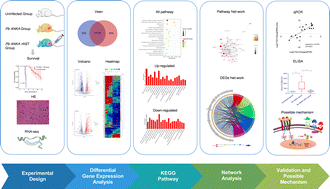RNA-seq-based transcriptome analysis of the anti-inflammatory effect of artesunate in the early treatment of the mouse cerebral malaria model†
Abstract
Background: cerebral malaria (CM) is an important complication of malaria with a high mortality rate. Artesunate is recommended as the first-line artemisinin compound treatment for severe malaria. Due to the difficulty of obtaining brain tissue samples clinically, the use of animals to research host responses to CM parasite infections is necessary. Rodent malaria models allow for detailed time series studies of host responses in multiple organs. To date, studies on the transcriptome of severe malaria are only limited to the parasites in the peripheral blood of patients, and there is little data on the transcriptional changes in brain tissue in mice with CM treated with artesunate. Method and Result: in this study, fresh tissue samples (three biological replicates per mouse) from the same area of the brain in each animal were collected from the uninfected, Plasmodium berghei ANKA-infected and artesunate-treated C57BL/6 mice, and then transcriptome research was performed by the RNA-seq technique. Differentially expressed genes (DEGs) included Il-21, Tnf, Il-6, Il-1β, Il-10, Ifng, and Icam-1. Among which, Il-6, Il-10, Tnf-α and Il-1β were further verified and validated via qRT-PCR and ELISA. This revealed that Il-1β (p < 0.0001), Il-10 (p < 0.05) and Tnf-α (p < 0.05) were significantly up-regulated in the Pb ANKA-infected versus uninfected group, while Il-1β (p < 0.0001) and Tnf-α (p < 0.05) were significantly down-regulated after artesunate treatment. All DEGs were closely related to the top 3 artesunate treatment pathways, including the JAK-STAT signaling pathway, apoptosis, and Toll-like receptor signaling pathway. Conclusion: the mechanism of improving the prognosis of cerebral malaria by artesunate may not only involve the killing of plasmodium but also the inhibition of a cytokine storm in the host. This study provides new insights into the molecular mechanism by which artesunate improves the prognosis of cerebral malaria.



 Please wait while we load your content...
Please wait while we load your content...